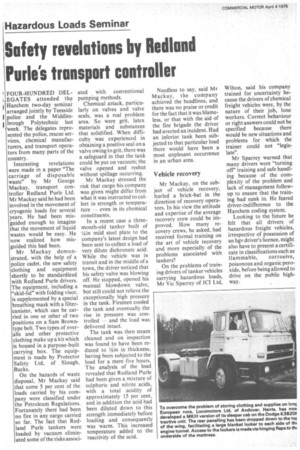Safety revelations by Hedlund Furies transport controller
Page 24

If you've noticed an error in this article please click here to report it so we can fix it.
FOUR-HUNDRED DELEGATES attended the Hazchem two-day seminar arranged jointly by Teesside police and the Middles brough Polytechnic last week. The delegates represented the police, rescue services, chemical manufacturers, and transport operators from many parts of the country.
Interesting revelations were made in a paper "The carriage of disposable waste" by Mr George Mackay, transport controller Redland Purle Ltd. Mr Mackay said he had been involved in the movement of cryogenic loads for several years. He had been misguided enough to imagine that the movement of liquid wastes would be easy. He now realized how misguided this had been.
Mr Mackay demonstrated, with the help of a police cadet, the new safety clothing and equipment shortly to be standardized with Redland Purle drivers. The equipment, including a "skid-lid" with folding visor, is supplemented by a special breathing mask with a filtercanister, which can be carried in one or other of two positions on a Sam Browntype belt. Two types of overalls and other protective clothing make up a kit which is housed in a purpose-built carrying box. The equipment is made by Protector Safety Ltd, of Slough, Bucks.
On the hazards of waste disposal, Mr Mackay said that some 5 per cent of the loads carried by his company were classified under the Petroleum Regulations. Fortunately there had been no fire in any cargo carried so far. The fact that Redland Purle tankers were loaded by vacuum eliminated some of the risks associ ated with conventional pumping methods.
Chemical attack, particularly on valves and valve seals, was a real problem area. So were grit, latex materials and substances that solidified. When difficulty was experienced in obtaining a positive seal on a valve owing to grit, there was a safeguard in that the tank could be put on vacuum; the valve opened and reshut without spillage occurring.
Mr Mackay stressed the risk that cargo his company was given might differ from what it was instructed to collect in strength or tempera ture even in its chemical constituents.
In a recent case a threemonth-old tanker built of 'Ain mild steel plate to the company's latest design had been sent to collect a load of very dilute dichronate acid. While the vehicle was in transit and in the middle of a town, the driver noticed that his safety valve was blowing off. He stopped, opened his manual blowdown valve, but still could not relieve the exceptionally high pressure in the tank. Firemen cooled the tank and eventually the rise in pressure was controlled and the load was delivered intact.
The tank was then steam cleaned and on inspection was found to have been reduced to 1/2in in thickness, having been subjected to the load for a mere five hours. The analysis of the load revealed that Redland Purle had been given a mixture of sulphuric and nitrite acids, with a total acidity of approximately 15 per cent, and in addition the acid had been diluted down to this strength immediately before loading and consequently was warm. This increased temperature added to the reactivity of the acid. Needless to say, said Mr Mackay, the company achieved the headlines, and there was no praise or credit for the fact that it was blameless, or that with the aid of the fire brigade the driver had averted an incident. Had an inferior tank been subjected to that particular load there would have been a most unplesant occurrence in an urban area.
Vehicle recovery Mr Mackay, on the subject of vehicle recovery, hurled a brick-bat in the direction of recovery operators. In his view the attitude and expertise of the average recovery crew could be improved. How many recovery crews, he asked, had received formal training on the art of vehicle recovery and more especially of the problems associated with tankers?
On the problems of training drivers of tanker vehicles carrying hazardous loads, Mr Vic Sparrey of ICI Ltd, Wilton. said his company trained for uncertainty because the drivers of chemical freight vehicles were, by the nature of their job, lone workers. Correct behaviour or right answers could not be specified because there would be new situations and problems for which the trainer could not "legislate".
Mr Sparrey warned that many drivers were "turning off' training and safe handling because of the complexity of the problem and lack of management followup to ensure that the training had sunk in. He feared driver-indifference to the Hazchem coding system.
Looking to the future he felt that all drivers of hazardous freight vehicles, irrespective of possession of an hgv driver's licence, might also have to present a certificate in classifications such as flammable, corrosive, poisonous and organic peroxide, before being allowed to drive on the public highway.




































































































